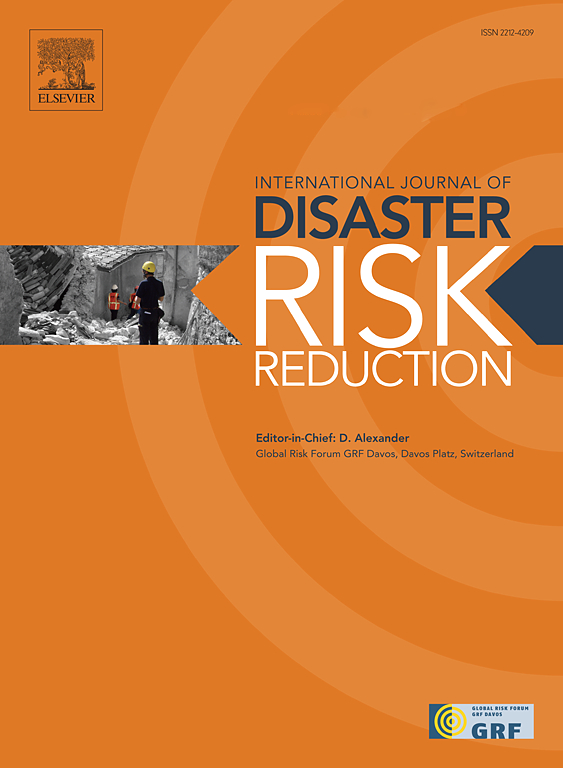输电线塔降雨诱发滑坡的定量风险评估——以重庆市国家级输电保护区为例
IF 4.5
1区 地球科学
Q1 GEOSCIENCES, MULTIDISCIPLINARY
International journal of disaster risk reduction
Pub Date : 2025-07-19
DOI:10.1016/j.ijdrr.2025.105715
引用次数: 0
摘要
近年来,地质灾害频发,严重威胁着输电网的安全有效运行。然而,输电塔滑坡的定量风险评估仍不发达。本研究旨在通过建立原始的技术框架,提供中国重庆国家输电线路保护区(NTLPR)沿线滑坡风险的定量分布。特别是,静态和动态数据都被用于模拟滑坡的易感性和危险性。然后,根据输电塔与滑坡跳动边界之间的距离,评估输电塔对滑坡的潜在脆弱性。最后,根据经典风险评估理论,建立滑坡影响下塔楼的定量风险分布图。结果表明,滑坡危险性随降雨侵蚀强度的时空分布呈现一致的变异性。随着滑坡数据的更新和缓解措施的实施,与塔楼相关的脆弱性和风险都会随着时间的推移而发生动态变化。脆弱性曲线分析显示,距离滑坡溃退边界274 m以内的输电塔脆弱性等级非常高,每塔潜在损失100万元。具体而言,高/超高脆弱性塔的数量从2002-2010年的487座减少到2019-2020年的75座,总体风险降低65.83%(从10383万元降低到3548万元)。所得结果为输电网络管理提供了可解释的风险缓解方案,并有望成为电力行业滑坡管理的有效框架。本文章由计算机程序翻译,如有差异,请以英文原文为准。
Quantitative risk assessment for rainfall-induced landslides of transmission line towers: the case of Chongqing national transmission protection regions
In recent times, the increasing frequency of geohazards has been threatening the safe and effective operation of power transmission networks. However, the quantitative risk assessments of landslides for transmission towers remain underdeveloped. The present study aims at providing the quantitative landslide risk distribution along the Chongqing National Transmission Line Protection Regions (NTLPR) in China by establishing an original technical framework. Particularly, both static and dynamic data are used for modeling the susceptibility and hazard of landslides. Then, the potential vulnerability of transmission towers to landslides was assessed based on the distance between the towers and landslide run-out boundaries. Finally, following the classical risk assessment theory, the quantitative risk distribution maps of towers affected by landslides is established. The results showed that landslide hazard exhibits a consistent variability in relation to the spatiotemporal distribution of rainfall erosion intensity. As landslide data is updated and mitigation measures are implemented, both the vulnerability and risk associated with the towers undergo dynamic changes over time. The vulnerability curve analysis reveals transmission towers within 274 m of landslide run-out boundaries exhibit very high vulnerability level, with potential losses of 1 million RMB per tower. Specifically, the number of high/very high vulnerability towers was reduced from 487 (2002–2010) to 75 (2019–2020), resulting in a 65.83 % decrease in overall risk (from 103.83 to 35.48 million RMB). The obtained results provide an interpretable risk mitigation scheme for the management of power transmission networks, and are expected to become an effective framework for landslide management in the power industry.
求助全文
通过发布文献求助,成功后即可免费获取论文全文。
去求助
来源期刊

International journal of disaster risk reduction
GEOSCIENCES, MULTIDISCIPLINARYMETEOROLOGY-METEOROLOGY & ATMOSPHERIC SCIENCES
CiteScore
8.70
自引率
18.00%
发文量
688
审稿时长
79 days
期刊介绍:
The International Journal of Disaster Risk Reduction (IJDRR) is the journal for researchers, policymakers and practitioners across diverse disciplines: earth sciences and their implications; environmental sciences; engineering; urban studies; geography; and the social sciences. IJDRR publishes fundamental and applied research, critical reviews, policy papers and case studies with a particular focus on multi-disciplinary research that aims to reduce the impact of natural, technological, social and intentional disasters. IJDRR stimulates exchange of ideas and knowledge transfer on disaster research, mitigation, adaptation, prevention and risk reduction at all geographical scales: local, national and international.
Key topics:-
-multifaceted disaster and cascading disasters
-the development of disaster risk reduction strategies and techniques
-discussion and development of effective warning and educational systems for risk management at all levels
-disasters associated with climate change
-vulnerability analysis and vulnerability trends
-emerging risks
-resilience against disasters.
The journal particularly encourages papers that approach risk from a multi-disciplinary perspective.
 求助内容:
求助内容: 应助结果提醒方式:
应助结果提醒方式:


